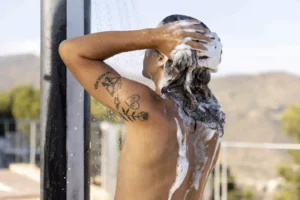You finally choose to get rid of that tattoo or your ex-girlfriend/boyfriend’s name on yourself, and maybe you regret getting a wild style back in college. For anyone looking into the past and wanting to make some changes, tattoo removal is a straightforward procedure that works. How about showering for laser tattoo removal? Should you scrub with wild abandon or try to be careful? In part three of our tattoo removal after-care series, we get deep about post-tattoo removal cleanliness and the tips for keeping your skin spotless without slowing down healing!
How Tattoo Removal Works
This isn’t a fairy tale where you wave your wand and the ink goes away; tattoo removal is a journey. It’s a gradual process where lasers are used to disintegrate tattoo pigments underneath your skin, treating different layers of the tattoo in each session, and slowly but surely fading it away with each treatment.
The biggest thing to realize is that tattoo removal is not a one-shot deal. Factors considered for the number of sessions include the colour of the ink and how deeply it was implanted in your skin, as well as the thickness or thickness of your skin. You have to be patient as your skin heals between treatments.
As such, you can expect some minor and temporary side effects like redness, swelling or blistering. All of this is part of the healing process as your body eliminates the broken pigment particles from your system. After-care is vital to aid in speedy healing and also decrease the problems.
Factors that Affect Healing

Many variables may affect the healing process of tattoo removal. Size and location of the tattoo are significant factors; larger tattoos would need more time to heal than others. This care may also need to be taken with more sensitive areas such as the ribs or ankles.
Your skin type and health are critical factors in the healing process. Skin that is in good condition heals quicker, so maintaining your skin’s health with regular care once the tattoo has been removed will ensure a faster healing process. Things such as smoking, sun exposure, and even your stress levels can play into how fast or slow you heal.
Laser removal, while it can be a little painful, typically has a shorter healing duration than other processes. Following the proper post-treatment care detailed by your specialist is key to achieving great healing results, so you can be confident in the effectiveness of this method.
In some cases, understanding these factors can help you make a good decision about your tattoo removal process and prepare for recovery.
Tattoo Removal Showers: What You Need to Know
Finally, after the tattoo is removed, showering becomes mandatory to improve cleanliness and speed up healing. You must practice good habits for taking a shower after the removal of your ink to achieve excellent results.
Another consideration is that you should never directly expose your treated skin to high-pressure water or Extreme heat/cold during showers. Hot water facilitates skin irritation and delays the healing process. Instead, use lukewarm water.
Do not use a loofah, scrubber, or washcloth on the treated area. When showering after tattoo removal, pat it dry. Do not scrub or rub the area too hard, as this can only irritate and possibly damage your delicate skin.
Following your shower, use a clean towel to pat dry the area being treated instead of rubbing it. This gentle, hands-off approach also prevents any extra friction that could easily disrupt healing.
Shower After Tattoo Removal: Be Hygienic. Harmful chemicals and exfoliants should be avoided, as they will only delay the healing process, which may increase complications.
Showering After Tattoo Removal

Showers are essential for getting your tattoo removed correctly. Firstly, we need to avoid hot water for the treated area as it can cause irritation and slow down healing. Instead, use lukewarm warm water to cleanse the skin.
When showering, avoid scrubbing or harsh rubbing of the area with a loofah and towel. Instead, use a clean cloth to gently pat the skin, as this can cause unnecessary friction that may damage your healing skin.
Cleaning the area with mild, fragrance-free soap can keep it free of dirt without causing further irritation. Make sure to rinse well to avoid leaving soap residue that could potentially irritate sensitive skin post-treatment.
Remember to moisturize following your bath with the mild cream or ointment that they suggest for this technique. This will assist in retaining skin moisture and promoting recovery.
Myths and Misconceptions: Shower After Tattoo Removal

Read on to learn about some of the myths and facts regarding showering after undergoing tattoo removal. One of the most common myths is that you should stop coming into contact with water altogether to avoid causing damage to your healing skin. When you get a piercing, light showers are generally okay as long as the after-care instructions have been followed.
Despite common belief, hot water does not promote healing. It is actually very irritating to the skin and will make your recovery time longer. Cool or lukewarm water is best when showering after tattoo removal.
Many individuals assume that employing harsh soaps on the location or rubbing it strongly will certainly deal with this concern quicker. In reality, this can result in infections and, worse yet, slow down the healing process. As skin may be a little more sensitive during these few days, you want to make sure that you are gently caring for your epidermis.
Let’s filter through the myths before showering after getting a tattoo removed so you can enjoy smooth sailing and a successful healing journey randomly resting on your path.
Other Methods for Keeping Clean While Healing
Cleanliness is important during this healing phase when the tattoo removal process has already started or just finished to avoid potential infections and allow for proper skin recovery. If you are instructed not to shower for 24 hours but really want to be clean, may slipper sinks can be due (see?).
Children can be easily cleaned with gentle cleansing wipes and Micelles water for a delicate wash of the treated area without flooding. The items can successfully cleanse dirt and bacteria off your skin without being harsh on its sensitive surface.
The other way around is to use dry shampoo to wash hair. By keeping the treated area dry in the shower, you can maintain fresh-looking hair while not risking damaging your healing tattoo site.
Also, try using antibacterial sprays or ointments from your tattoo removal technician. These can provide some protection against infection in the region and also promote healing.
Always remember to contact your care provider before utilizing any new sanitation process as you heal after tattoo removal.
Conclusion
Showering after tattoo removal is essential for a healthy healing process. Make sure to consult your tattoo removal professional and treat your skin accordingly for the best results possible. If left unattended, your tattoo removal healing may be completed on time. It could cause complications, but if you know what to do with the process of showering after a body art treatment, they can help speed up the healing process as well as minimize any negative effects. But the most important thing right now is to clean and baby your skin.

